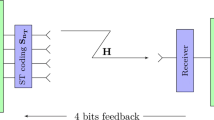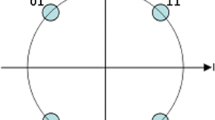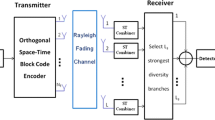Abstract
In this paper, we give design methods for three-transmit-antenna space-time codes which have reasonable parameters. A few examples are given to show that some unitary space-time codes constructed with our methods are better than the previously best-known ones.
Similar content being viewed by others
References
B. Hochwald and W. Sweldens, Differential unitary space-time modulation, IEEE Trans. Commun., 2000, 48(12): 2041–2052.
B. Hughes, Differential space-time modulation, IEEE Trans. Inform. Theory, 2000, 46(7): 2567–2578.
V. Tarokh and H. Jafarkhani, A differential detection scheme for transmit diversity, J. Sel. Areas Commun., 2000, 18(7): 1169–1174.
Y. Jing and B. Hassibi, Three-transmit-antenna space-time codes based on SU(3), IEEE Trans. Signal Processing, 2005, 53(10): 3688–3702
X. B. Liang and X. G. Xia, Unitary signal constellations for differential space-time modulation with two transmit antennas: parameteric codes, optimal designs, and bounds, IEEE Trans. Inform. Theory, 2002, 48(8): 2291–2322.
C. P. Xing, Constructions of unitary space-time codes from number fields, to be published.
A. Shokrollahi, B. Hassibi, B. Hochwald, and W. Sweldens, Representation theory for high-rate multiple-antenna code design, IEEE Trans. Inform. Theory, 2001, 47(6): 2335–2367.
H. Wang and X. G. Xia, Upper bounds of rates of complex orthogonal space-time block codes, IEEE Trans. Inform. Theory, 2003, 49(10): 2788–2796.
Author information
Authors and Affiliations
Corresponding author
Additional information
The research is supported by the National Natural Science Foundation of China under Grant No. 60673074.
Rights and permissions
About this article
Cite this article
Tong, H., Yu, F. Constructions of Three-Transmit-Antenna Space-Time Codes. Jrl Syst Sci & Complex 20, 381–385 (2007). https://doi.org/10.1007/s11424-007-9033-2
Received:
Issue Date:
DOI: https://doi.org/10.1007/s11424-007-9033-2




